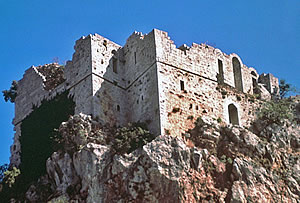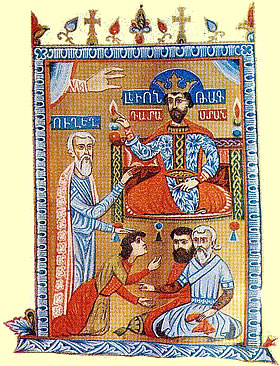Kingdom of Cilicia (part 2)
Hetum I and the Mongols
 King Hetum, pictured here as a Franciscan monk after his abdication, on a 14th century drawing, from Venice, Bilioteca Marciana
King Hetum, pictured here as a Franciscan monk after his abdication, on a 14th century drawing, from Venice, Bilioteca Marciana
Meanwhile, the enormous Empire of Mongols expanded on the East, and the Turks were consecutively ousted from the Greater Armenia, Syria and Mesopotamia. During the ruling of Hetum I, Mongols approached the borders of Cappadocia and Cilicia. A far-sighted politician, Hetum I was prompt to establish the good relations with Khan Batu.
Later, when Khan Mangu assumed the title of Great Khan, Hetum I made a long trip to the Golden Horde with the many sumptuous presents. As a result, the military alliance with the Mongols was reaffirmed. The Mongols supported Hetum I in his conflict against the Sultans of Konya and Aleppo. The next Armenian kings also maintained friendly connections with the Khans of Golden Horde. The situations drastically changed however, as the Mongols declined in power and were gradually converted to Islam.
Cilician Kingdom in danger
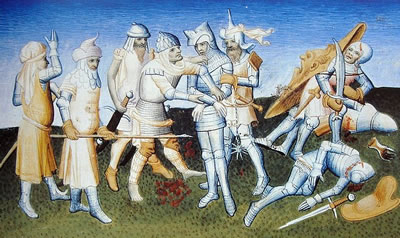 Battle of Mari, from Le Livre des Merveilles, early 15th century. The future Armenian King Levon II is captured (pictured in the middle), and his brother Thoros is killed (fallen, right).
Battle of Mari, from Le Livre des Merveilles, early 15th century. The future Armenian King Levon II is captured (pictured in the middle), and his brother Thoros is killed (fallen, right).
In 1266, the Mamluk Sultan Beibars summoned Hetum I to abandon his allegiance to the Mongols, laying several territorial claims. The Mamlukes marched on Cilicia, and a battle, known as Disaster of Mari took place on August 24, 1266. The Armenian forces led by two of King Hetum’s sons, Levon (the future king Levon II) and Thoros, were defeated. Leo was made a prisoner, and Thoros was killed in battle.
To return his son, Hetum I paid a huge ransom, and made serious territorial concessions to Mamlukes. 3 years later, he abdicated in favor of his son, became a monk and died in a monastery.
By the beginning of the 14th century, the aggressive Mamlukes dynasties becoming stronger and dangerous, the Armenian Kings had no way out but seeking protection of the European monarchs. The King Levon III repeatedly sent messengers to Rome promising the reunion of the Armenian and Catholic churches. Later his brother Oshin I tried to make alliance with Philip V, King of France. Also Leon IV, Oshin’s son asked Philip VI to render assistance. But the European leaders, although sympathetic, were not able or willing to intervene.
End of Rubenids
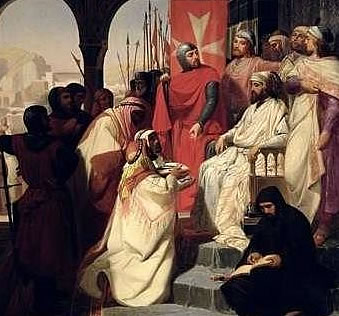 Constantine III, seating on his throne, is surrounded by Knights of the Order of St. John. This 1844 painting by Henri Delaborde is named Knights of the Order of St. John of Jerusalem Restoring Religion in Armenia in 1347
Constantine III, seating on his throne, is surrounded by Knights of the Order of St. John. This 1844 painting by Henri Delaborde is named Knights of the Order of St. John of Jerusalem Restoring Religion in Armenia in 1347
Leon IV was the last king of the Rubenids dynasty. Then, the descendants of Armenian branch of the royal Lusignan family ruled Cilicia. John Lusignan, who came to throne under the name of Constantine III, tried to impose Catholicism. He invited a large number of European knights to his court.
The country was already depleted as a result of the permanent Moslem invasions. As a matter of fact, the Christian Cilicia was doomed. The surrounding Moslem states feared new possible Crusades, and often considered the Christian Cilician Armenia as a potential source of conflicts, and a constant pretext for European Kingdoms to interfere.
Fall of the Kingdom
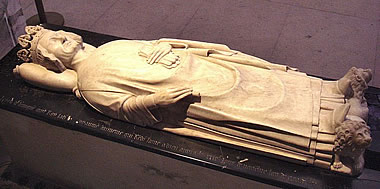 Tomb of Levon V, the last king of Cilician Kingdom, at Basilique Saint Denis, France. Photo source: Wikimedia Commons
Tomb of Levon V, the last king of Cilician Kingdom, at Basilique Saint Denis, France. Photo source: Wikimedia Commons
Under the ruling of Constantine IV, the Cilician Armenians gained perhaps their last victory, defeating the troops of Mamelukes near Alexandria. After Constantine’s death in 1364 the Cilician throne remained unoccupied for more than 2 years. Finally, Levon V, the last Armenian King, was elected in 1366. 8 years later, after a series of fatal battles against the superior enemy he locked himself in the Kapan fortress, but soon surrendered. The Mamelukes sent him to Egypt when he remained imprisoned for several years. Later the King of Castile mediated for his liberation. Levon V died in Paris in 1393.


